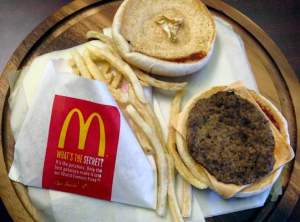Chiropractor Thinks 2-Year-Old McDonald’s Happy Meal Will Convince People To Avoid Fast Food

This 2-year-old Happy Meal looks only slightly less appetizing than it did when it was purchased, and it’s not because of some secret ingredient. (via Omaha.com)
“We have it on a glass platter so everyone can see it,” the chiropractor tells Omaha.com. “Its been exposed to the air, and it’s still intact. There are so many preservatives in these processed foods that it will never mold.”
Never? Ever? Shocking!
We’ve covered these “oh my gawd, McDonald’s doesn’t rot!” claims before, and everything we’ve learned over the years is that the intact appearance of ancient fast food burgers isn’t the result of some miraculous anti-rotting preservative or food chemistry voodoo, but the shape and size of the food, along with how it’s stored.
See, the mere passage of time doesn’t cause old food to rot and grow mold. For that, you need to throw in bacteria, spores… and perhaps most importantly, moisture.
Each of the food components in a Happy Meal — the beef patty, the fries, the bun — are reasonably dry to begin with, and they all have a lot of surface area through which any remaining moisture can evaporate.
If you then keep these same items in a dry area and away from creatures (including humans) that might try to eat them, chances are they will just keep on being dried-out versions of the foods they once were.
People expect the bread to get moldy because they have probably seen countless old half-finished loaves of sliced bread turn green in the bag. But that plastic bag is probably keeping moisture inside the slices, allowing for mold to grow. Put a hamburger bun in the open air for a few weeks and you could end up with a bread hockey puck that is inedible but which isn’t overrun by fuzzy mold.
Back in 2010, the folks at SeriousEats put several burger-related hypotheses to the test by allowing both McDonald’s burgers and homemade burgers age under various conditions — stored on a plate in the open air, no wrapper; homemade bun; toasted bun; stored in the fast food wrapper; no salt added; etc. — and spent 25 days monitoring the sandwiches for rot and mold growth.
None of the beef patties turned rotten during this time period. Some of the larger burgers showed evidence of mold growth on the patty, but the smaller patty — the kind you’d see in a Happy Meal — did not grow mold because it dried out much faster than the larger patties.
In fact, the only way the SeriousEats testers could get the burgers to grow mold like one would expect was to store them in plastic sandwich bags. That resulted in moldy buns after about a week.
Want more consumer news? Visit our parent organization, Consumer Reports, for the latest on scams, recalls, and other consumer issues.

